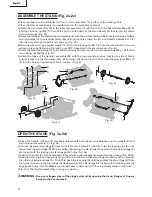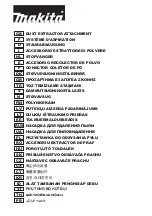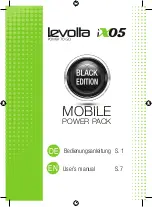
The safe use of this product requires an understanding of the information on the tool and in this operator’s
manual as well as a knowledge of the project you are attempting. Before use of this product, familiarize
yourself with all operating features and safety rules.
• Anti-kickback Pawls:
Kickback is a hazard in which the workpiece is thrown back toward the operator.
The teeth on the anti-kickback pawls point away from the workpiece. If the workpiece should be pulled
back toward the operator, the teeth dig into the wood to help prevent or reduce the possibility of kickback.
• Bevel Scale:
The easy-to-read scale on the front of the cabinet shows the exact blade angle.
• Blade:
For maximum performance, it is recommended that you use the 40-tooth, 10 in. carbide tipped
combination blade provided with your saw. The blade is raised and lowered with the height/bevel adjusting
handwheel. Bevel angles are locked with the bevel locking lever.
GLOSSARY OF TERMS
WARNING:
Do not use blades rated less than the speed of this tool. Failure to heed this warning
could result in personal injury.
11
English
• Blade Guard:
Always keep the guard down over the blade for through-sawing cuts.
• Bevel Locking Lever:
This lever under the worktable surface on the front of the cabinet, locks the
angle setting of the blade.
• Height/Bevel Adjusting Handwheel:
Located on the front of the cabinet, this handwheel is used
to lower and raise the blade for adjustments or blade replacement. The handwheel also makes
the adjustment for bevel angles easy.
• Fence Rails Locking Lever:
The lever under worktable surface on the left of the saw releases the
fence rails or locks it in place.
• Adjusting Knob:
This knob is under the worktable surface on the front of the saw. Turn it clockwise
will slide the fence rails to right. Turn it counter-clockwise will slide fence rails to left.
• Outfeed Support:
The outfeed support at the back of the tool gives the operator additional support
when cutting long workpieces.
• Miter Gauge:
The miter gauge aligns the wood for a cross cut. The easy-to-read indicator shows the
exact angle for a miter cut, with positive stops at 0°, 22.5° and 45°.
• Miter Gauge Grooves:
The miter gauge rides in these grooves on either side of the blade.
• Front Rail:
Front rail provides support for the front fence rail and rip fence.
• Rip Fence with a Narrow Fence:
A sturdy metal fence guides the workpiece and It can be �fixed on
three positions of the extension poles with rip fence locking knobs secure in place, the narrow fence can
supports workpiece that extends beyond the working table.
• Scale:
Located on the front rail, the easy-to-read scale provides precise measurements for rip cuts.
• Riving Knife:
A metal piece, slightly thinner than the saw blade, which helps keep the kerf open and
prevent kickback.
• Overload Reset Switch:
The saw is equipped with the overload reset switch to prevent the saw from
overload damage. The saw will stop if the machine was with overloaded cutting or low voltage. Turn the
ON/OFF switch to the OFF position and allow the motor to cool down for at least five minutes. And press
the overload reset switch button to resume the overload switch. After the motor has cooled down, turn
the ON/OFF switch to the ON position; the saw should now start.
• Arbor:
The shaft on which a blade or cutting tool is mounted.
• Working table:
Surface where the workpiece rests while performing a cutting operation.
• Kerf:
The material removed by the blade in a through-cut, or the slot produced by the blade in a non-
through or partial cut.
• Push Stick:
A push stick should be used for narrow ripping operations when work piece 6 in. (152 mm)
wide or less. These aids help to keep the operator’s hands well away from the blade.
• Kickback:
A hazard that can occur when the blade binds or stalls, throwing the workpiece back toward
the operator.
• Ripping or Rip Cut:
A cutting operation along the length of the workpiece.












































